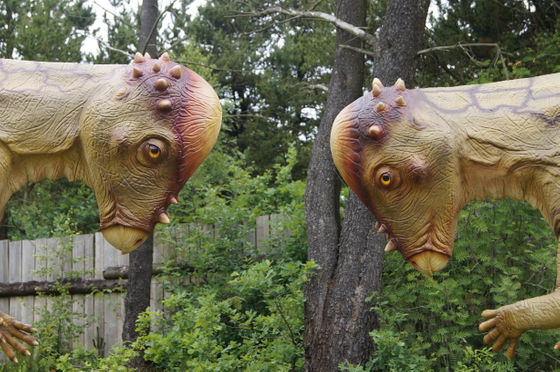Possibility that Pachycephalosaurus, ``stone head dinosaur'', had a duel with ``kickboxing and sumo'' instead of a head-butting battle

by
Pachycephalosaurus is called ``stone-headed dinosaur'' in Japanese because the upper part of its skull is made of a thick dome-shaped bone, and its scientific name means ``thick-headed lizard'' in Latin. It has been thought that they used this to determine their rank in the herd and to protect themselves from predators. However, new research has found that it may have been fighting with kickboxing that made full use of the tail like a kangaroo instead of headbutting, and sumo wrestling while pushing heads.
Helmet-headed dinosaurs kickboxed like kangaroos, new study suggests | Live Science
https://www.livescience.com/pachycephalosaur-dinosaurs-kickboxed-like-kangaroos
Did pachycephalosaurs head butt? New research says it kicked like a kangaroo - Deseret News
https://www.deseret.com/2022/11/8/23447312/dinosaur-kicks-like-kangaroo-pachycephalosaurs
The most distinctive feature of Pachycephalosaurus is its dome-shaped skull, which is 25-30 cm thick. From this, it has been hypothesized that Pachycephalosaurus may have violently bumped heads in groups to determine a leader or fight over territory since the earliest fossils were discovered. I was. The bighorn sheep and musk ox that inhabit North America are known as modern creatures that similarly headbutt as a ritual struggle.

by
Pachycephalosaurus, which is said to have lived in rocky areas where fossils are difficult to remain, like the bighorn sheep living on the rocky surface of the Rocky Mountains, has almost no fossils other than a hard skull. Therefore, Curry Woodruff, a paleontologist at the Frost Science Museum in Miami, and others conducted a study to create and verify a 3D model from the well-preserved Pachycephalosaurus skeleton found in the Hell Creek Formation in the western United States. .
When the research team used a laser scanner to scan the skeleton of Pachycephalosaurus and create a virtual 3D model, it was found that the vertebrae on the back of Pachycephalosaurus were shaped like stackable dishes. I was. It has long been known that Pachycephalosaurus has such a spine, and paleontologists thought that it was ``to disperse the impact of high-speed headbutt''.
However, when Woodruff et al. compared models of Pachycephalosaurus vertebrae with other animals famous for headbutting, none of the animal skeletons had a similar shape. Therefore, when the research team searched for more animals with bones similar to Pachycephalosaurus, it was found that the kangaroo's spine resembled Pachycephalosaurus.

by
According to Woodruff, the Pachycephalosaurus skeleton has bones similar to kangaroos, such as pelvis and tail bones, in addition to the vertebrae. From this, the research team believes that this discovery reinforces the theory that ``Pachycephalosaurus was in a position to support its weight with its tail'' that appeared around the 1970s.
Also, when fighting between males, kangaroos sometimes support their weight with their tails and then kick with both feet, so Mr. Woodruff said, ``It's just a hypothesis, but Pachycephalosaurus also has its own kickboxing posture. There is a possibility that it was acting like this.'
Just because Pachycephalosaurus had a kangaroo-like skeleton doesn't mean it didn't headbutt at all, but it did have an anatomically different skeleton than modern headbutting animals. Therefore, it is considered that collision at high speed was not possible. Therefore, if Pachycephalosaurus had a headbutt duel, it would have been a ``sumo wrestling'' type where wrestlers pushed their heads together, rather than a ``jousting'' type in which knights rushed forward on horseback . Isn't it?' said Woodruff.

by Rasmus Skov Larsen
Woodruff presented the findings at the Annual Meeting of the Society of Vertebrate Paleontology (SVP) in Toronto, Canada, November 2-5, 2022, but is still subject to peer review. The article was not published in a peer-reviewed journal.
``It's the way we look at certain animals,'' Joseph Peterson, a paleontologist and Pachycephalosaurus expert at the University of Wisconsin-Oshkosh, told Live Science. Pachycephalosaurus is a mysterious dinosaur, but this study will add a new perspective to how we see Pachycephalosaurus.'
Related Posts:







